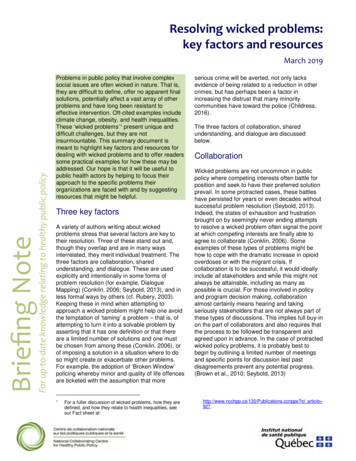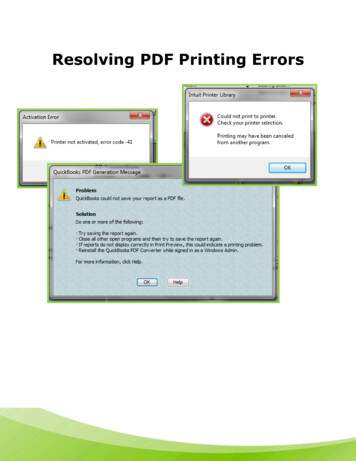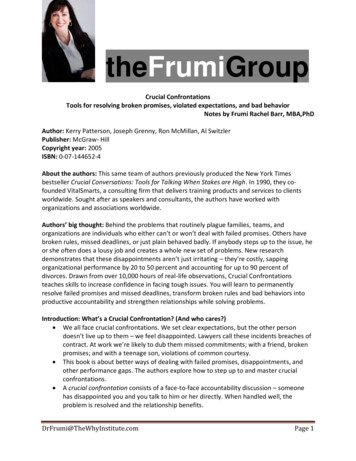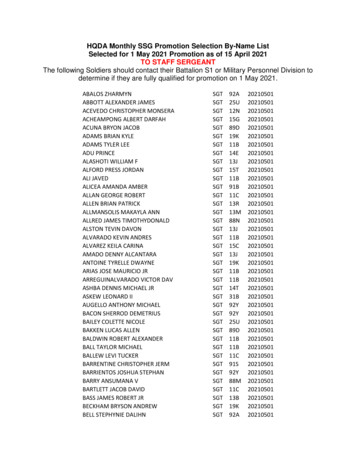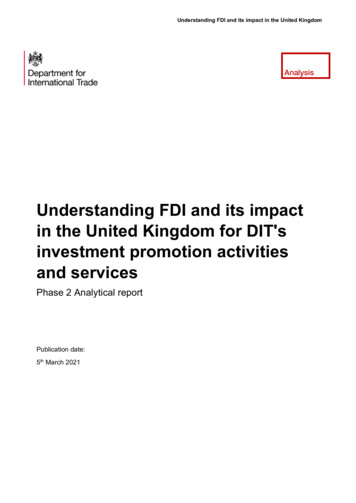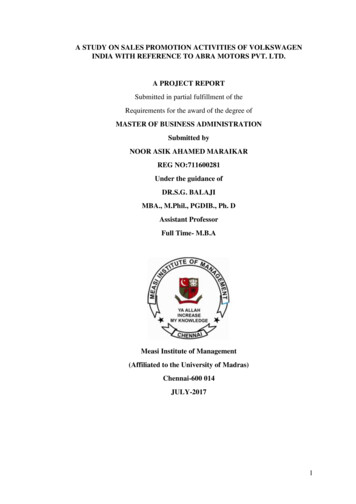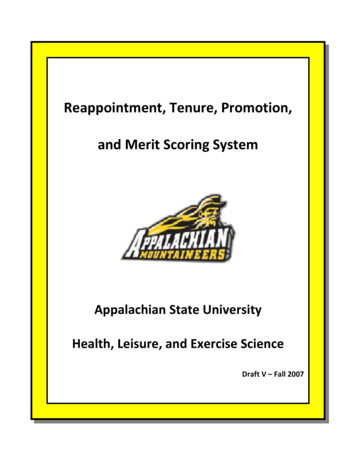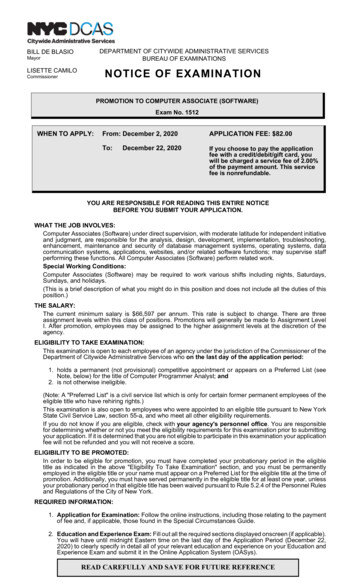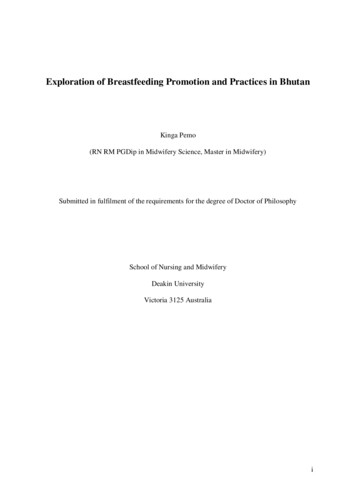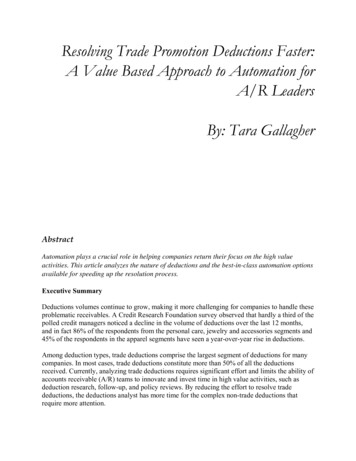
Transcription
Resolving Trade Promotion Deductions Faster:A Value Based Approach to Automation forA/R LeadersBy: Tara GallagherAbstractAutomation plays a crucial role in helping companies return their focus on the high valueactivities. This article analyzes the nature of deductions and the best-in-class automation optionsavailable for speeding up the resolution process.Executive SummaryDeductions volumes continue to grow, making it more challenging for companies to handle theseproblematic receivables. A Credit Research Foundation survey observed that hardly a third of thepolled credit managers noticed a decline in the volume of deductions over the last 12 months,and in fact 86% of the respondents from the personal care, jewelry and accessories segments and45% of the respondents in the apparel segments have seen a year-over-year rise in deductions.Among deduction types, trade deductions comprise the largest segment of deductions for manycompanies. In most cases, trade deductions constitute more than 50% of all the deductionsreceived. Currently, analyzing trade deductions requires significant effort and limits the ability ofaccounts receivable (A/R) teams to innovate and invest time in high value activities, such asdeduction research, follow-up, and policy reviews. By reducing the effort to resolve tradedeductions, the deductions analyst has more time for the complex non-trade deductions thatrequire more attention.
Automation plays a crucial role in helping companies return their focus on the high valueactivities. This article analyzes the nature of deductions with a focus on trade deductions and thebest-in-class automation options available for speeding up the resolution process.IntroductionThe complex buying and selling of products in a B2B environment has many challenges.Typically, manufacturers identify distribution channels to sell their products. The distributionchannels are composed of retailers, distributors, dealers, service providers or othermanufacturers. Complexities arise due to the following practices: The flow of goods and the flow of money have different end-points and different cycles asvarious departments and teams are involved in bulk delivery, payments, procurement and soforth.The unit price of the product varies based on customer reputation, sales, volume, promotionsand seasonality.A gap exists between the shipment of goods and the receiving of payments, which has to beaccounted for by the receivables team in the form of days sales outstanding (DSO).Managing deductions, disputes and chargebacks are among the challenges that arise due to thiscomplex buying and selling process. During the payment process, the customer may pay less thanwhat is outlined in the invoice due to earned discounts, faulty deliveries, etc. The amount short onthe invoice in the payment process is termed a deduction.Typically, deduction practitioners divide the incoming deductions into two types:1. Trade DeductionsThe deductions which arise from promotions, discounts, markdowns and advertising are calledtrade deductions. Such deductions are easy to investigate and resolve because the promotions anddiscounts are generally planned in advance, and tracking a deduction against a trade promotion iseasier to navigate.2. Non-Trade DeductionsNon-trade deductions make up all other types of deductions, such as shortages, damageddeliveries, invoice errors, etc. Such deductions might be of mixed types, are often unpredictableand complex, and may require collaboration from teams across the organization.A rise in deductions volume is indicative of a few different circumstances. It could mean thatretailers and distributors have become more aggressive in claiming deductions. It could alsomean that suppliers and manufacturers have not been able to successfully avoid preventabledeductions. Deductions left unaddressed could make a significant dent in the bottom line. But theheavy manual effort required to resolve deductions has traditionally meant that the cost of fixingthe issues would overrun the benefits. A deduction could take anywhere from a few days to morethan six months to get resolved, depending on the nature of the deduction. Many manufacturers
prefer to write off low and medium value deductions to make things simpler, whichunfortunately adds up over time, leading to significant losses in the long term.As volumes continue to rise, the problem demands a fresh perspective. Companies have had toincrease their efforts on the timely review and follow-up of deductions, and establish crossfunctional teams for better accountability. However, all these undertakings are resource intensiveand the costs could run high. Therefore, the value to automate processes for deductionsmanagement is tremendous, and especially high for trade deductions, which account for thelargest proportion of all deduction types.In a recent CRF survey, almost 50% of the all surveyed participants cited trade promotions (inthe form of advertising, discounts, rebates, etc.) as a major cause of deductions. The sameresponse is much higher – around 70% - for a few specific industries such as apparels, footwear,cosmetics, accessories and food & beverages.Trade deductions have two important traits: Trade deductions arrive in bulkTrade deductions are easy to resolve compared to some of the other deduction typesThese traits make trade deductions ideal candidates for automation because: A large part of the monotonous day-to-day deductions work could be automatedComplex analysis is not required, so human intervention could be minimizedThe next sections will reveal the challenges and explore the automation possibilities for tradedeductions.Challenges in Trade Promotion ResolutionFigure 1: Resolution Process for Trade Promotion Deductions
Typically, a trade deduction proceeds through a set of stages for resolution (See Figure 1). Afterthe deduction arrives, the back-up documentation, such as claims, PODs, etc. need to becollected from different sources. Once all the information and proof of documentation have beencompiled, the individual trade deductions need to be matched against the correlated tradepromotion and verified for legitimacy. Additional cross-team research, typically involving thesales teams, needs to be carried out, usually before invalidating a deduction. If the tradepromotion deduction is found to be valid, credit is issued or the amount is written off and thededuction is closed. If the deduction is found to be invalid, the deduction is denied and theamount is sent back for collections.Deductions teams face several challenges at various stages in the process as outlined below.Identify Trade Promotion DeductionsFrom the different types of deductions arriving from various sources, the trade deductions needto be identified and coded for processing separately from other deductions or claims.Maintain the Document BackupsDownloading, sorting, indexing and linking deduction documentation is an onerous and timeconsuming task. The multiple, varying sources from which the claims and POD documents needto be retrieved (website, email, EDI, mail) makes the task difficult to standardize. Additionally,time is lost extracting relevant trade promotion and deduction data from the aggregateddocuments before research is even able to start.Match Deduction Cases to the Corresponding Trade PromotionCurrently, the deductions analyst has to toggle between the ERP, trade promotions managementand deductions management systems to identify the trade promotion from which the deductionhas been taken. Data from the trade promotion, such as the promotion ID, committed amount,disbursed amount, etc., needs to be carefully matched before approving the deduction.Research the Deduction CasesTrade deduction cases may require follow-up with the sales, marketing and customer relationshipteams. Without a systematic way to track the case, scrolling through thousands of deductionsbecomes extremely difficult. The end result is delayed resolution and poor accountability.Customer CorrespondenceDeduction correspondence letters, such as denial correspondence or follow-up on invaliddeductions needs to be composed, scheduled and tracked across thousands of cases. Manualhandling of correspondences leads to poor customer relationships, irregular or no follow-up andlow deduction recovery.
Automation TechniquesAutomation of manual, repetitive and low-value tasks is a very successful method to speed uptrade deduction resolution. In the resolution process discussed earlier, each step of the processcontains many repetitive tasks which could be automated and the resources freed-up for workingon high-value and complex activities. These techniques also bring down the cost of processingtrade deductions drastically. The sections below cover the automation of low-value tasks indetail.Backup AggregationMany medium and large customers upload their claim documents to a web portal and provide thesuppliers/manufacturers with the login. Many customers use other formats, such as emails, EDI,and paper documents to share the details of the claims. Backup aggregation involvesdownloading and maintaining documents, such as claims and PODs from these various sourcesbefore starting the deductions research. Collecting backup for thousands of deductions casesevery day becomes a time-consuming and tedious task. Moreover, extracting the associateddeductions documentation is only the beginning of the overall deductions research workflow.Fortunately, backup aggregation is a routine task with fairly consistent steps for most of theincoming debit memos. Modern technology provides options that allow analysts to shift theirattention from these mundane tasks to more valuable tasks. Best-in-class backup automationsolutions identify the source, read and understand the source message, extract the data andstandardize it.Critical Properties for Backup AutomationEfficiencyThe purpose of implementing backup automation technology is to free-up as much resource timeas possible by automating manual tasks. It is important to measure and benchmark thepercentage of the manual work being eliminated in this fashion. For example, if someone isrequired to manually identify sources before the automation technology is able to download it, itis not efficient enough. Additionally, businesses are looking to rapidly implement solutions andrealize the benefits faster. Only a few vendors are able to provide a plug-and-play solution forbackup aggregation in deductions management.VersatilityVersatility is the degree to which the technology is source-agnostic. In selecting a solution, besure to find one that supports extraction from all types of sources such as websites, email,images, and EDI. Check for accuracy in standardizing the document backups to simplifyresearch for deduction analysts. Also, be sure the solution provides pre-integrated downloadfacilities to all the major retailers’ claim websites in the customer portfolio.
A solution with end-to-end process automation could automate as much as 95%, if not more, ofthe A/R tasks to resolve trade deductions. Additionally, about 20% of the time spent by thedeductions team could be freed-up using automation technology.Aggregate-SegregateDownloading backup documentation in a source-agnostic, efficient and accurate way is only apart of the whole solution. Linking these documents to the original trade promotion deductioncase and sorting, indexing and categorizing the documents must also be addressed. Sometimesthe volumes are so immense that companies with a large inflow of deductions need to employadditional teams to handle the document management overflow.Every deduction document needs to be sorted and indexed in a particular way so that the analystis able to easily locate the piece when required. This is done based on various parameters, forexample, the type of deduction (trade or non-trade), the responsible department (operations,sales, or warehouse), customers by buying volume (large and small), customers by products, andso on. This quickly becomes very complex when all deduction categories are added together forthousands of customers.The next step to this process is the linking/matching of each document to a particular deduction.Again, this is a manual process that involves identifying attributes on debit memos, includingclaim ID, debit memo number and dates, searching the open deduction in the ERP or otherapplications, and tying the document to a particular deduction when a match is found. Currenttechnology reduces this humongous scale of work to three easy steps as follows:1. IdentificationThe type of document and the details within, such as customer ID, amount and type of deduction,purchase order and invoice number, need to be identified to link it to the appropriate deductioncase. However, most existing software solutions are unable to accurately extract the informationdue to legacy technology issues. Consider the claim document image shown in Figure 2:
Figure 2: Sample Claim DocumentThe information elements that a deduction analyst would require are the claim #, the claim date,PO #, claim amount and so on. Optical Character Recognition (OCR) is widely used to read theimage document and extract this data. A typical OCR engine divides the document into capturerectangles, thereby aligning each data piece in the image into a box. Further, OCR reads the datapixel by pixel from each box and converts it into human readable text. However, a number ofdifficulties cause issues with OCR, including: Not every claim document is formatted in the same wayNot every claim document has the same informationOther formatting differences occur – font type, color, size, printing accuracy, etc.Hence, the accuracy of OCR is low, and dedicated resources may be required to check for errorsand exceptions for the documents being processed.The use of Artificial Intelligence (AI) and Robotic Process Automation (RPA) are the keys tosolving the problem
promotion and verified for legitimacy. Additional cross-team research, typically involving the sales teams, needs to be carried out, usually before invalidating a deduction. If the trade promotion deduction is found to be valid, credit is issued or the amount is written off and the deduction is closed. If the deduction is found to be invalid .
